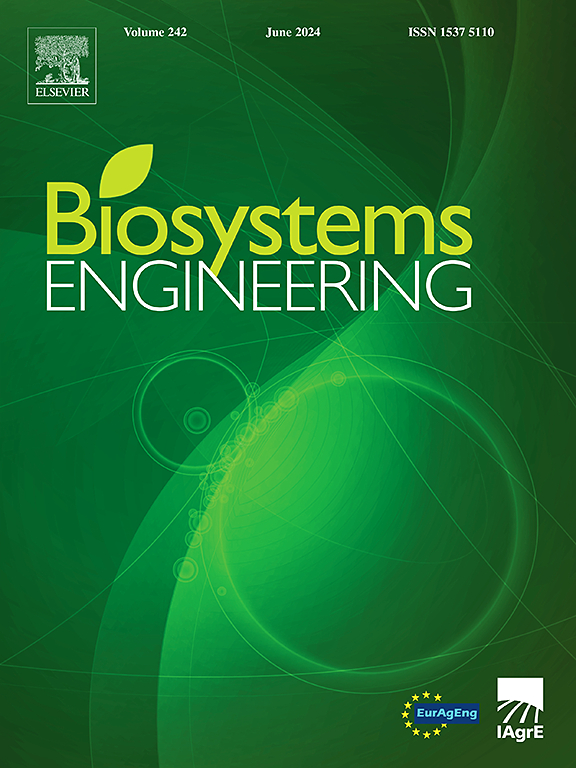设计和优化颠簸增强调节辊均匀苜蓿茎损伤
IF 5.3
1区 农林科学
Q1 AGRICULTURAL ENGINEERING
引用次数: 0
摘要
调理是苜蓿干草收获的关键步骤,直接影响苜蓿干草的品质。为了确定影响条件反射效果的关键因素,建立了条件反射模型。针对常规调质辊对阀杆损伤不均匀的问题,设计了一种表面凹凸结构。通过在空间上安排这些凸起,滚子对苜蓿茎施加了微摩擦作用,从而增强了结构破坏。参数优化研究阐明了碰撞直径、非干涉距离和螺旋角对阀杆断裂效率的影响。采用有限元法进一步完善了设计。随后,采用Box-Behnken实验设计来优化三个关键操作参数:进给速度、滚轮间隙和滚轮转速。然后进行了干燥试验,比较了不同设计的滚筒的调理性能。结果表明,在凹凸直径2.85 mm、互不干涉距离1.61 mm、螺旋角23.85°的情况下,断枝数最少(0.67),非断裂损伤发生数最多(7.67)。为了最大限度地提高调理效果,同时使调理损失率和能量消耗最小,确定了最优参数为辊转速为683 rmin - 1,辊间隙为3.13 mm,进料速率为779 g s - 1。使用带凸起滚筒的苜蓿含水率在前60分钟内下降到40%左右。与其他两种调理辊相比,该设计表现出优越的性能。本文章由计算机程序翻译,如有差异,请以英文原文为准。
Design and optimisation of bump-enhanced conditioning rollers for uniform alfalfa stem damage
Conditioning is a critical step in alfalfa hay harvesting, directly influencing its quality. A conditioning model was developed to identify the key factors affecting conditioning effectiveness. To address the issue of uneven stem damage caused by conventional conditioning rollers, a surface bump structure was designed. By arranging these bumps spatially, the rollers applied micro-rubbing actions to the alfalfa stems, thereby enhancing structural disruption. Parametric optimisation studies clarified how bump diameter, non-interference distance and helix angle influence stem disruption efficiency. The design was further refined using the finite element method. Subsequently, a Box–Behnken experimental design was employed to optimise three key operational parameters: feed rate, roller gap, and roller rotational speed. Drying tests were then conducted to compare the conditioning performance of different roller designs. Results showed that the minimum number of broken branches (0.67) and maximum number of non-fracture damage occurrences (7.67) were achieved with a bump diameter of 2.85 mm, a non-interference distance of 1.61 mm, and a helix angle of 23.85°. Aiming to maximise the conditioning while minimising the conditioning loss rate and energy consumption, the optimal parameters were determined to be a roller rotational speed of 683 r min−1, a roller gap of 3.13 mm and a feed rate of 779 g s−1. The moisture content of alfalfa conditioned using the roller with bumps dropped to around 40 % within the first 60 min. Compared with the other two conditioning rollers, this design demonstrated superior performance.
求助全文
通过发布文献求助,成功后即可免费获取论文全文。
去求助
来源期刊

Biosystems Engineering
农林科学-农业工程
CiteScore
10.60
自引率
7.80%
发文量
239
审稿时长
53 days
期刊介绍:
Biosystems Engineering publishes research in engineering and the physical sciences that represent advances in understanding or modelling of the performance of biological systems for sustainable developments in land use and the environment, agriculture and amenity, bioproduction processes and the food chain. The subject matter of the journal reflects the wide range and interdisciplinary nature of research in engineering for biological systems.
 求助内容:
求助内容: 应助结果提醒方式:
应助结果提醒方式:


